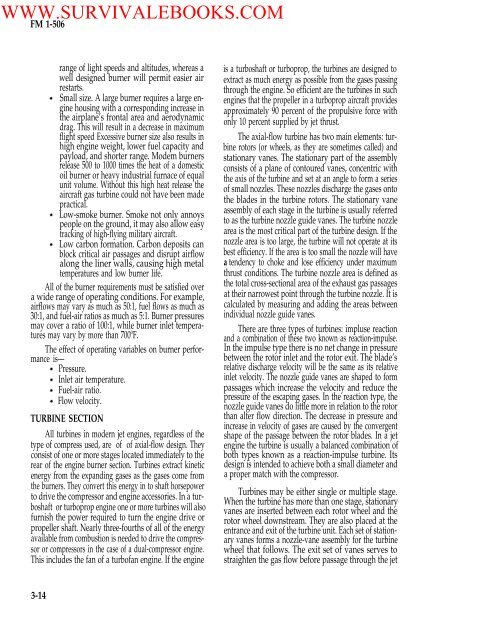FM 1-506 Fundamentals of Aircraft Power Plants ... - Survival Books
FM 1-506 Fundamentals of Aircraft Power Plants ... - Survival Books
FM 1-506 Fundamentals of Aircraft Power Plants ... - Survival Books
You also want an ePaper? Increase the reach of your titles
YUMPU automatically turns print PDFs into web optimized ePapers that Google loves.
WWW.SURVIVALEBOOKS.COM<strong>FM</strong> 1-<strong>506</strong>range <strong>of</strong> light speeds and altitudes, whereas awell designed burner will permit easier airrestarts.Small size. A large burner requires a large enginehousing with a corresponding increase inthe airplane’s frontal area and aerodynamicdrag. This will result in a decrease in maximumflight speed Excessive burner size also results inhigh engine weight, lower fuel capacity andpayload, and shorter range. Modem burnersrelease 500 to 1000 times the heat <strong>of</strong> a domesticoil burner or heavy industrial furnace <strong>of</strong> equalunit volume. Without this high heat release theaircraft gas turbine could not have been madepractical.Low-smoke burner. Smoke not only annoyspeople on the ground, it may also allow easytracking <strong>of</strong> high-flying military aircraft.Low carbon formation. Carbon deposits canblock critical air passages and disrupt airflowalong the liner walls, causing high metaltemperatures and low burner life.All <strong>of</strong> the burner requirements must be satisfied overa wide range <strong>of</strong> operating conditions. For example,airflows may vary as much as 50:1, fuel flows as much as30:1, and fuel-air ratios as much as 5:1. Burner pressuresmay cover a ratio <strong>of</strong> 100:1, while burner inlet temperaturesmay vary by more than 700ºF.The effect <strong>of</strong> operating variables on burner performanceis—Pressure.Inlet air temperature.Fuel-air ratio.Flow velocity.TURBINE SECTIONAll turbines in modern jet engines, regardless <strong>of</strong> thetype <strong>of</strong> compress used, are <strong>of</strong> <strong>of</strong> axial-flow design. Theyconsist <strong>of</strong> one or more stages located immediately to therear <strong>of</strong> the engine burner section. Turbines extract kineticenergy from the expanding gases as the gases come fromthe burners. They convert this energy in to shaft horsepowerto drive the compressor and engine accessories. In a turboshaftor turboprop engine one or more turbines will als<strong>of</strong>urnish the power required to turn the engine drive orpropeller shaft. Nearly three-fourths <strong>of</strong> all <strong>of</strong> the energyavailable from combustion is needed to drive the compressoror compressors in the case <strong>of</strong> a dual-compressor engine.This includes the fan <strong>of</strong> a turb<strong>of</strong>an engine. If the engineis a turboshaft or turboprop, the turbines are designed toextract as much energy as possible from the gases passingthrough the engine. So efficient are the turbines in suchengines that the propeller in a turboprop aircraft providesapproximately 90 percent <strong>of</strong> the propulsive force withonly 10 percent supplied by jet thrust.The axial-flow turbine has two main elements: turbinerotors (or wheels, as they are sometimes called) andstationary vanes. The stationary part <strong>of</strong> the assemblyconsists <strong>of</strong> a plane <strong>of</strong> contoured vanes, concentric withthe axis <strong>of</strong> the turbine and set at an angle to form a series<strong>of</strong> small nozzles. These nozzles discharge the gases ontothe blades in the turbine rotors. The stationary vaneassembly <strong>of</strong> each stage in the turbine is usually referredto as the turbine nozzle guide vanes. The turbine nozzlearea is the most critical part <strong>of</strong> the turbine design. If thenozzle area is too large, the turbine will not operate at itsbest efficiency. If the area is too small the nozzle will havea tendency to choke and lose efficiency under maximumthrust conditions. The turbine nozzle area is defined asthe total cross-sectional area <strong>of</strong> the exhaust gas passagesat their narrowest point through the turbine nozzle. It iscalculated by measuring and adding the areas betweenindividual nozzle guide vanes.There are three types <strong>of</strong> turbines: impluse reactionand a combination <strong>of</strong> these two known as reaction-impulse.In the impulse type there is no net change in pressurebetween the rotor inlet and the rotor exit. The blade’srelative discharge velocity will be the same as its relativeinlet velocity. The nozzle guide vanes are shaped to formpassages which increase the velocity and reduce thepressure <strong>of</strong> the escaping gases. In the reaction type, thenozzle guide vanes do little more in relation to the rotorthan alter flow direction. The decrease in pressure andincrease in velocity <strong>of</strong> gases are caused by the convergentshape <strong>of</strong> the passage between the rotor blades. In a jetengine the turbine is usually a balanced combination <strong>of</strong>both types known as a reaction-impulse turbine. Itsdesign is intended to achieve both a small diameter anda proper match with the compressor.Turbines may be either single or multiple stage.When the turbine has more than one stage, stationaryvanes are inserted between each rotor wheel and therotor wheel downstream. They are also placed at theentrance and exit <strong>of</strong> the turbine unit. Each set <strong>of</strong> stationaryvanes forms a nozzle-vane assembly for the turbinewheel that follows. The exit set <strong>of</strong> vanes serves tostraighten the gas flow before passage through the jet3-14
















